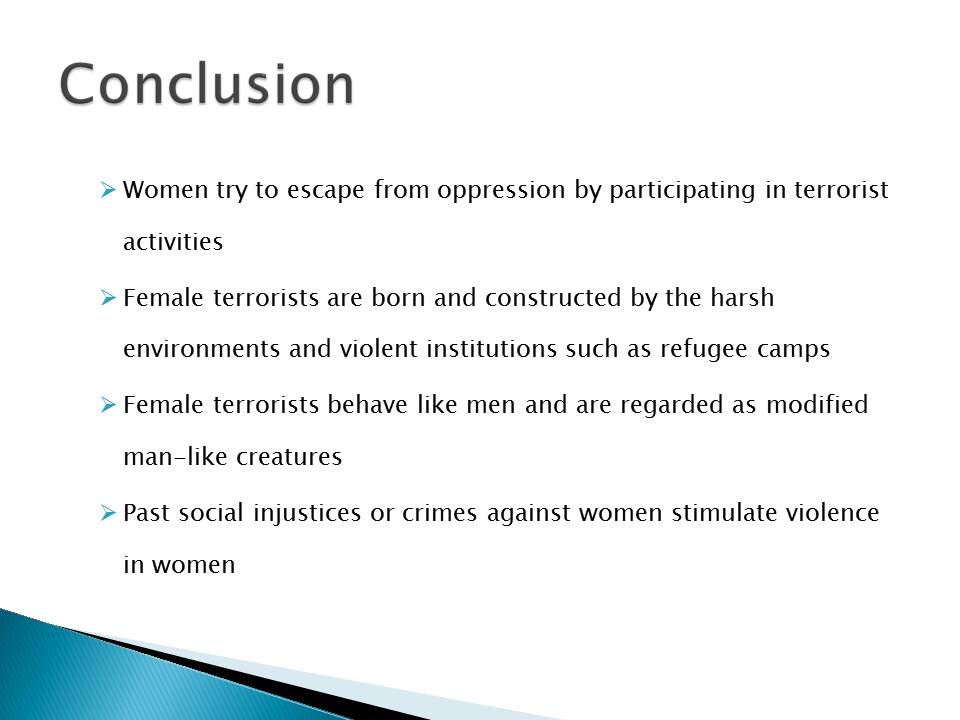Female terrorism and psychological factors
- Male and female terrorists vary in socio-psychological backgrounds;
- Galvin (1983) states that terrorism is a male-dominated activity and relates to struggling for power;
- Feminine characters do not inhibit female adaptations to the more brutal terrorism roles and activities;
- Since people do not expect any violent act from a woman, as they consider them non-violent, fragile and victim-like, female terrorists come as a surprise;
- From the psychological perspective, male and female terrorists differ in their socio-psychological backgrounds such as motives, connections and objectives of the violence;
- As Galvin demonstrated, terrorism is a male-dominated activity and is closely related to struggle for power. However, women destroy their female nature and resort to terrorism;
- Female terrorist deal with every sort of terrorism activity and feminism does not hinder them from performing dangerous and risky tasks associated with terrorism;
- As women are considered non-violent and fragile, female terrorism comes as a surprise to many as little harm is expected from female creatures;
- Women are frequently used for sexual purposes although terrorist groups banns love affairs;
- As the nature of terrorism is masculine, terrorism group destructs female self-esteem;
- God-like positions held by male leaders attracts female terrorists and constructs their female terrorist identity;
- As stated by O’ Rourke (2009, p. 681), same motives and circumstances drive both male and female attackers;
- Gender wise, terrorist groups propose equal treatment to both men and women. Even though women are used as sex pets, terrorist groups ban love affairs;
- Self-esteem among women within terrorist groups is relatively lowered since terrorism is regard as being masculine;
- Males hold key positions in terrorist groups. Charismatic and God-like male leaders have attracted women to join terrorist groups in search for identity;
- O’ Rourke carried a research that shows that the same motives drive both male and female attackers.


Female terrorism and sociological factors
- Research by Martha Crenshaw (2004, pg. 410-412) shows that personality factors and gender differences do not account for the terrorist behavior;
- Shared ideological commitment and group solidarity are more important determinants of terrorism responses than personal characteristics;
- Ariel Merari (2007) claims that suicidal bombers are individual rather than a group phenomenon;
- Root causes of terrorism include lack of democracy, lack of civil liberties and the rule of law, too rapid modernization, dictatorship, civil wars, history of violence, social injustices, etc.
- Sociological factors contribute to the development of female terrorists. Research by Martha Crenshaw (2004, pg. 410-412) shows that personality factors and gender differences do not account for the terrorist behavior;
- In the social world, terrorism has been demonstrated as a group activity rather than individualistic;
- However, Ariel Merari describes rare cases such as suicidal bombers where the terrorist behavior is an individualistic act rather than a group phenomenon;
- In any nation, terrorism results from one or a combination of factors such as lack of democracy, lack of civil liberties and the rule of law, too rapid modernization, dictatorship, civil wars, among others.
- Revenge, redemption, respect, and relationships motivate female terrorists;
- Religious and cultural differences modify methods used by terrorist groups. For instance, the Germany and Shining Path in Peru were radical socialists with no religious connection;
- Female terrorists can be used as collaborators, informers, human shield, recruiters, sexual baits and perpetrators of acts of destruction and death;
- Cultural and traditional habits can lead to female terrorism;
- Revenge due to loss of loved once, inability to conceive, inability to get a mate, and the alleged or real sexual misconduct together with relationship issues leads to sparks female violence;
- Religion and cultural beliefs can also lead to increased number of female terrorists. For instance, the Germany and Shining Path in Peru were radical socialists with no religious connection;
- With non-violent beliefs held by people about women, female terrorists can easily smuggle and transport arms used for criminal activities;
- Cultural and traditional discrimination against women, economic instability combined with patriarchal views of women roles lead to women resorting to violence.


Conclusion
- Women try to escape from oppression by participating in terrorist activities;
- Female terrorists are born and constructed by the harsh environments and violent institutions such as refugee camps;
- Female terrorists behave like men and are regarded as modified man-like creatures;
- Past social injustices or crimes against women stimulate violence in women;
- In conclusion, women escape oppression through terrorism activities. They do so in order to solve challenging live issues that they are born with such as discrimination and social injustices;
- Women resort to terrorist activities due to revenge, great frustration and anger brought about by the environment they live in;
- In the bid to revenge, female engage in terrorism, that for long has been regarded as a male activity. Some of the female terrorists leave children and motherhood for violence just for revenge;
- Social injustices and indiscrimination stimulate violence among women. For instance, Palestinian women became suicide bombers due to social injustices such discrimination due to infertility or rape;
- Religious beliefs play a role in nurturing terrorists. In addition, women are motivated by negative self-identity in the society;
- Loss of loved ones and psychological trauma accelerates construction of female terrorists;
- In conclusion, the environment and social factors nurtures female terrorists;
- Religious beliefs held by groups also play a significant role in terrorism. Palestinian and Chechen terrorists believed in becoming martyrs if they were killed prompting women to join the groups;
- Powerful terrorist leaders attract women who have lost loved ones, homes and relatives in a bid to revenge;
- Nobody is born a terrorist. Female terrorists evolved to become what they are.

